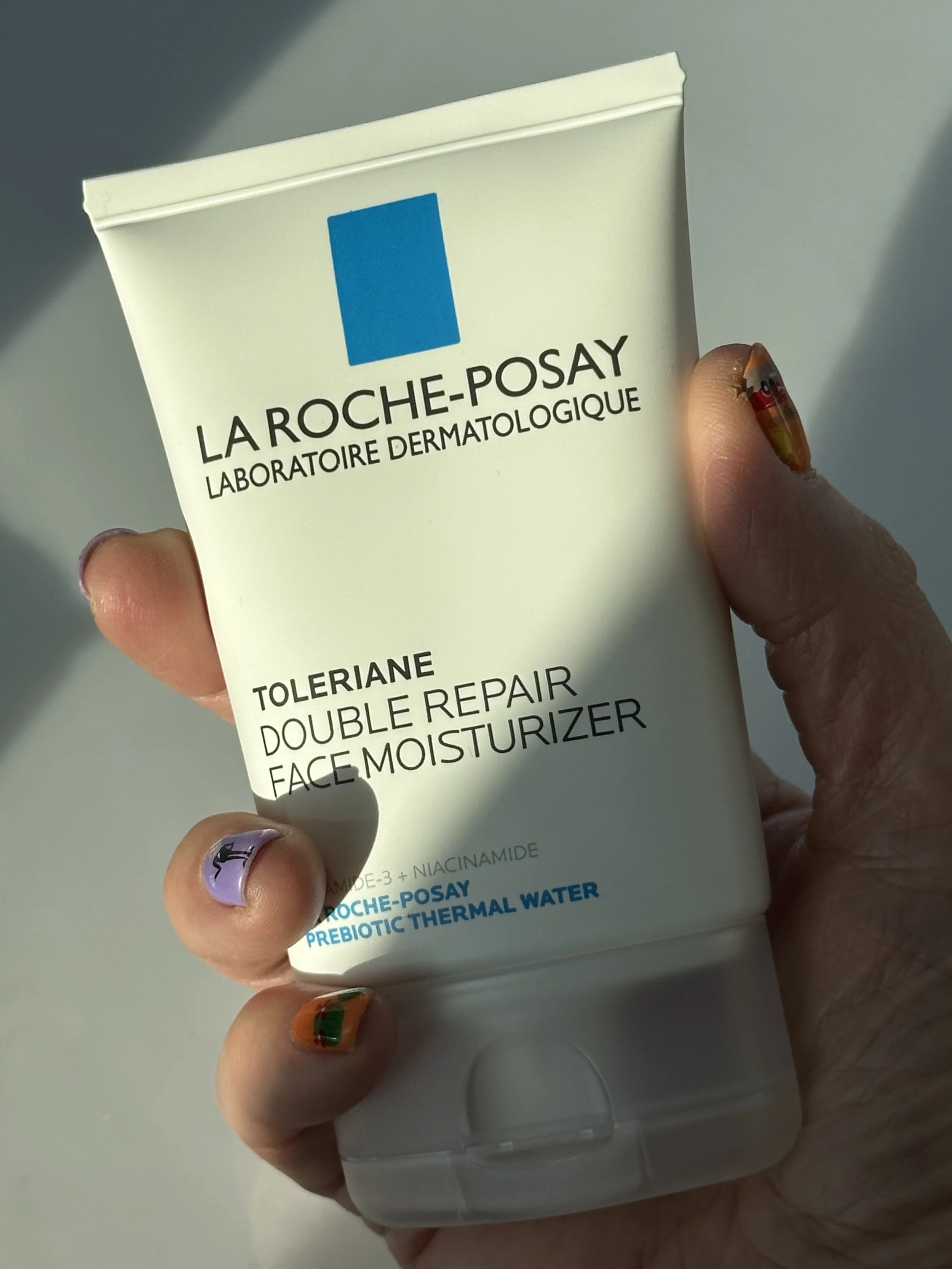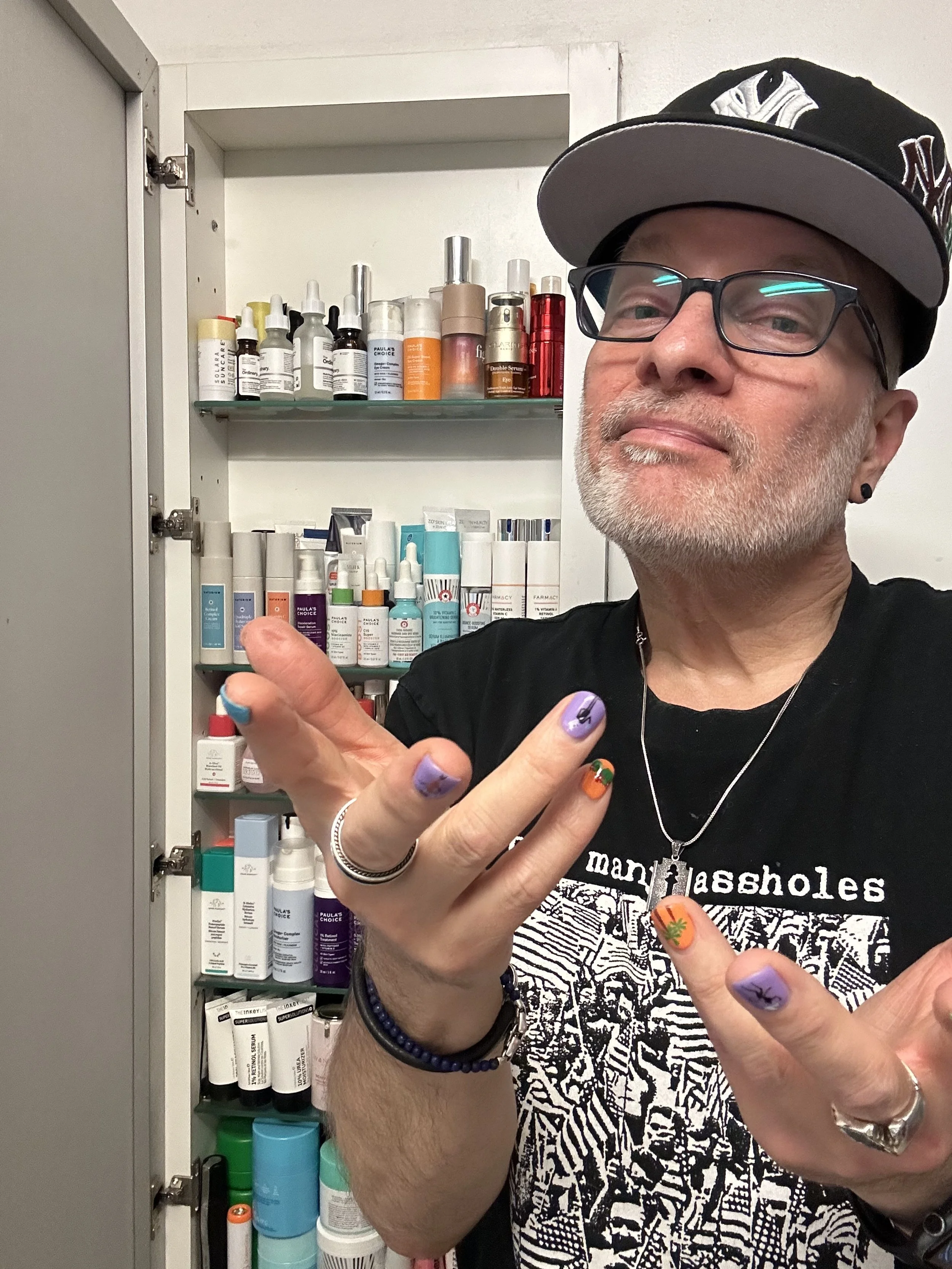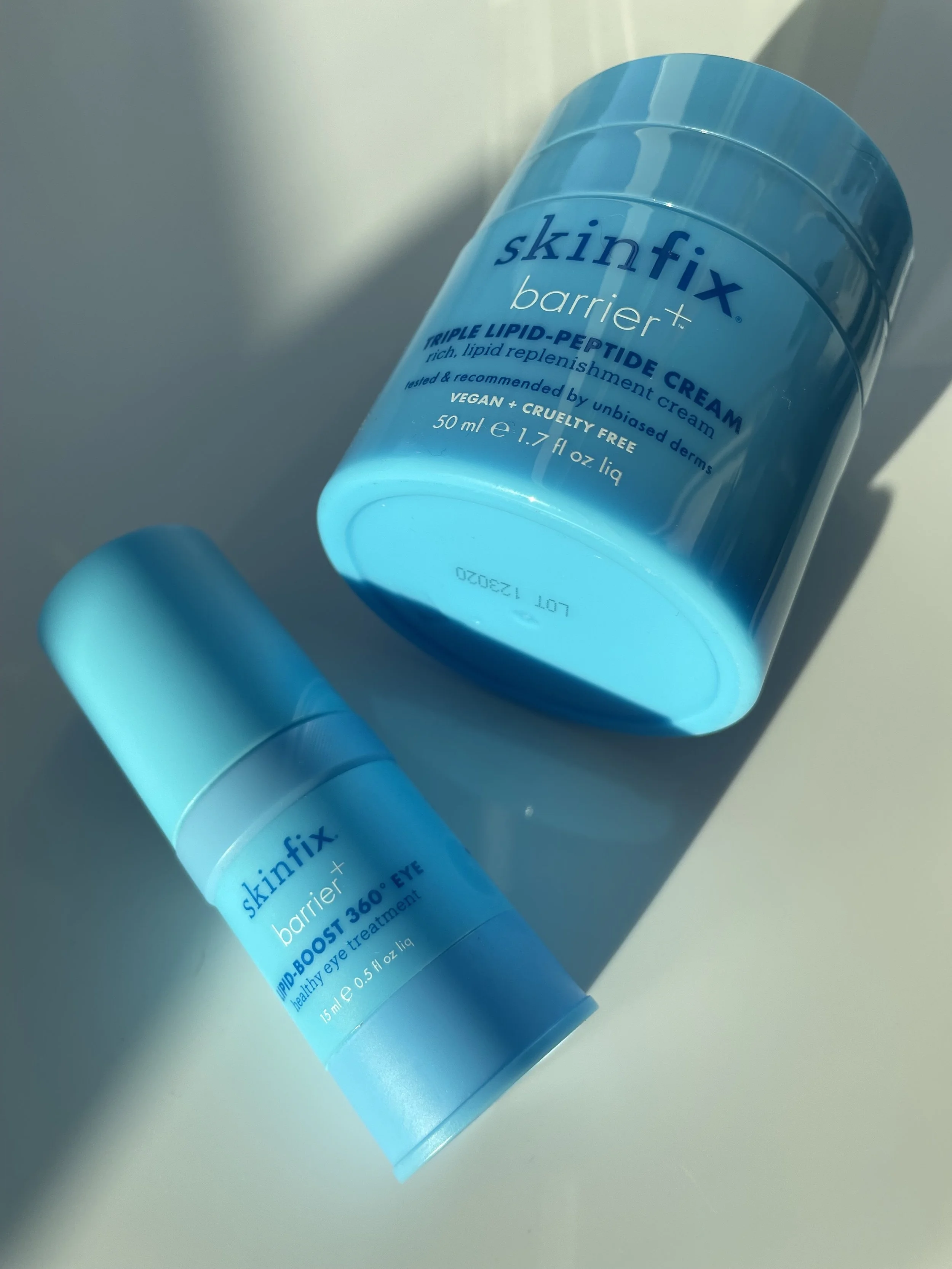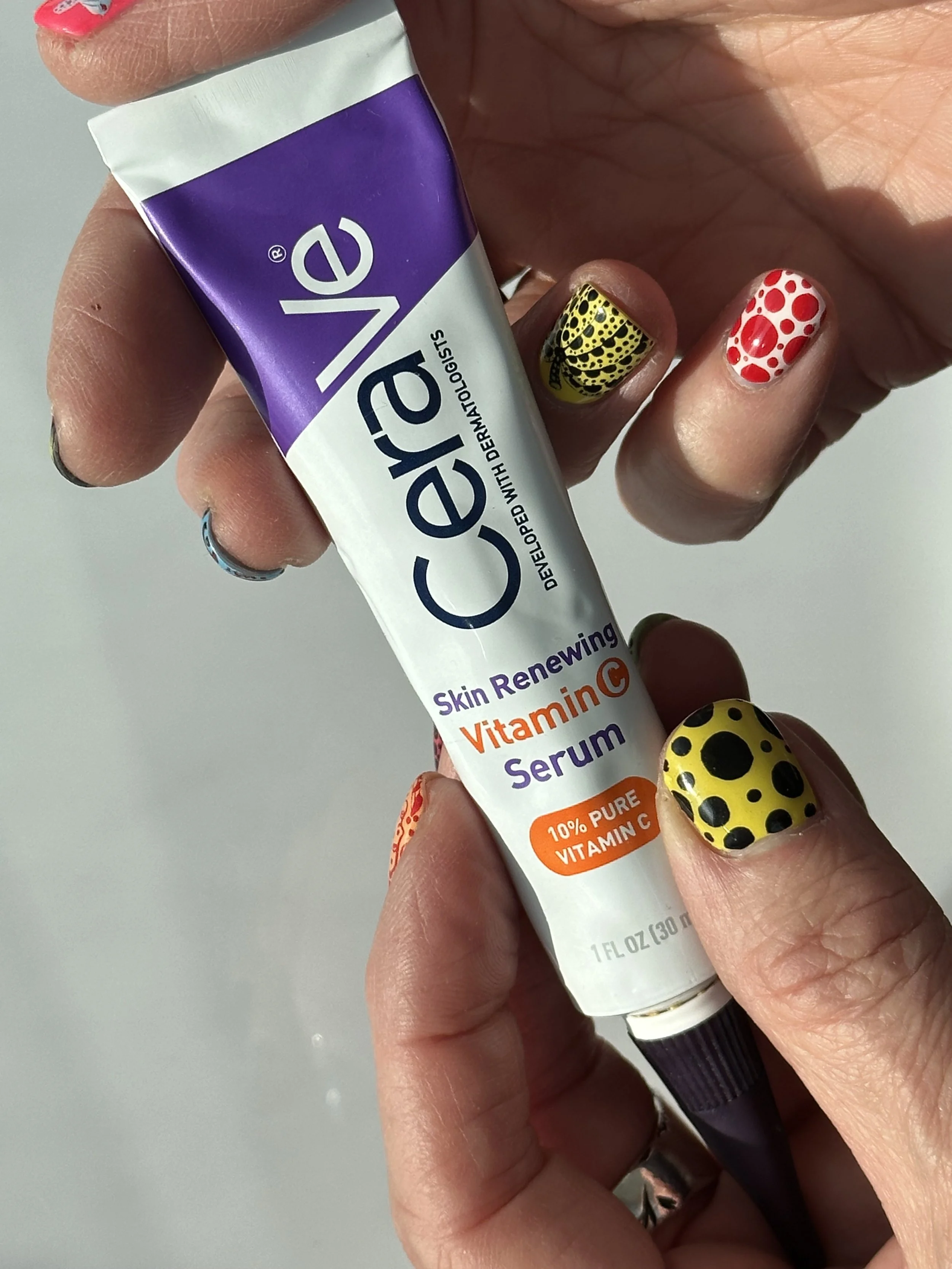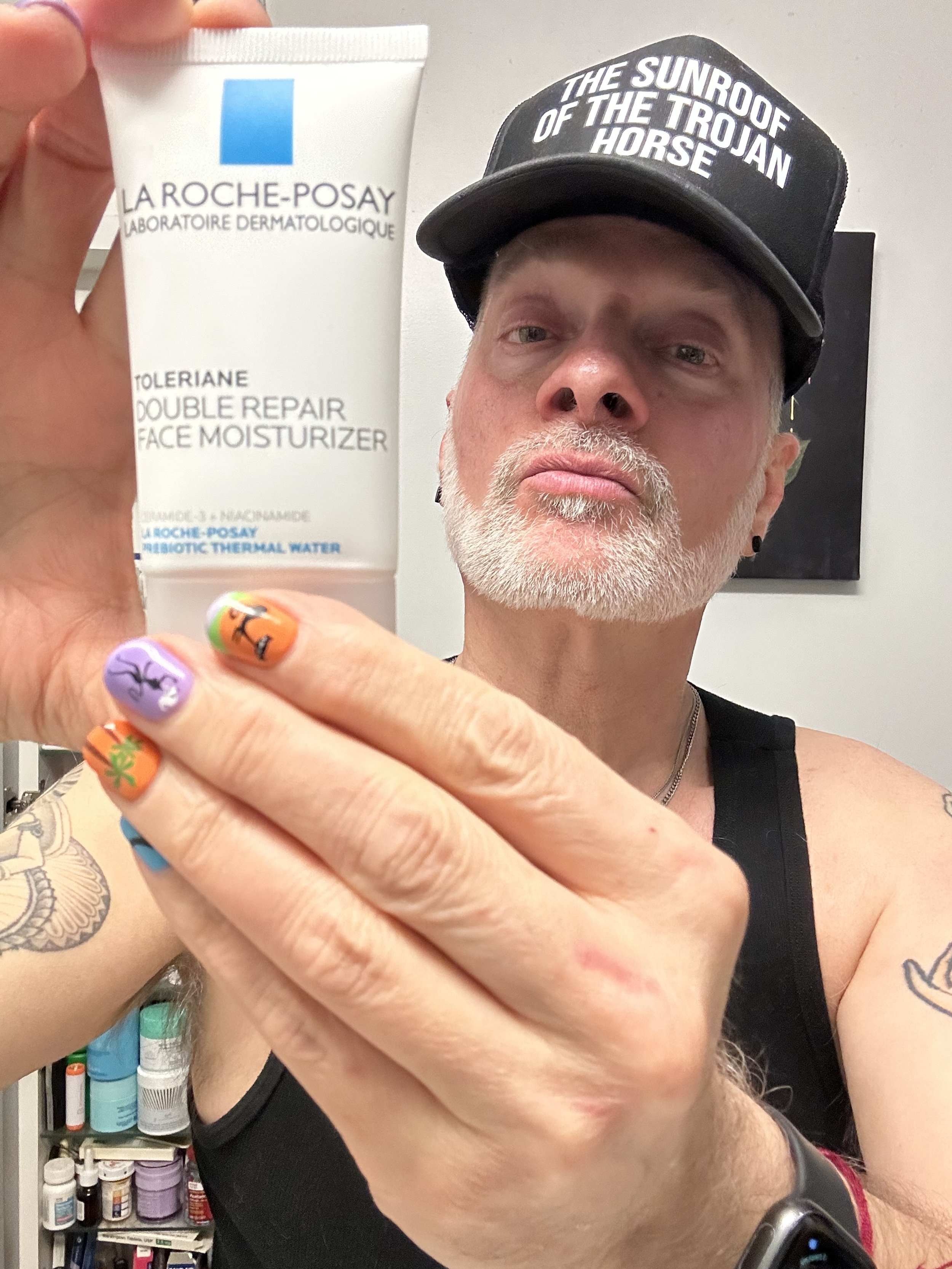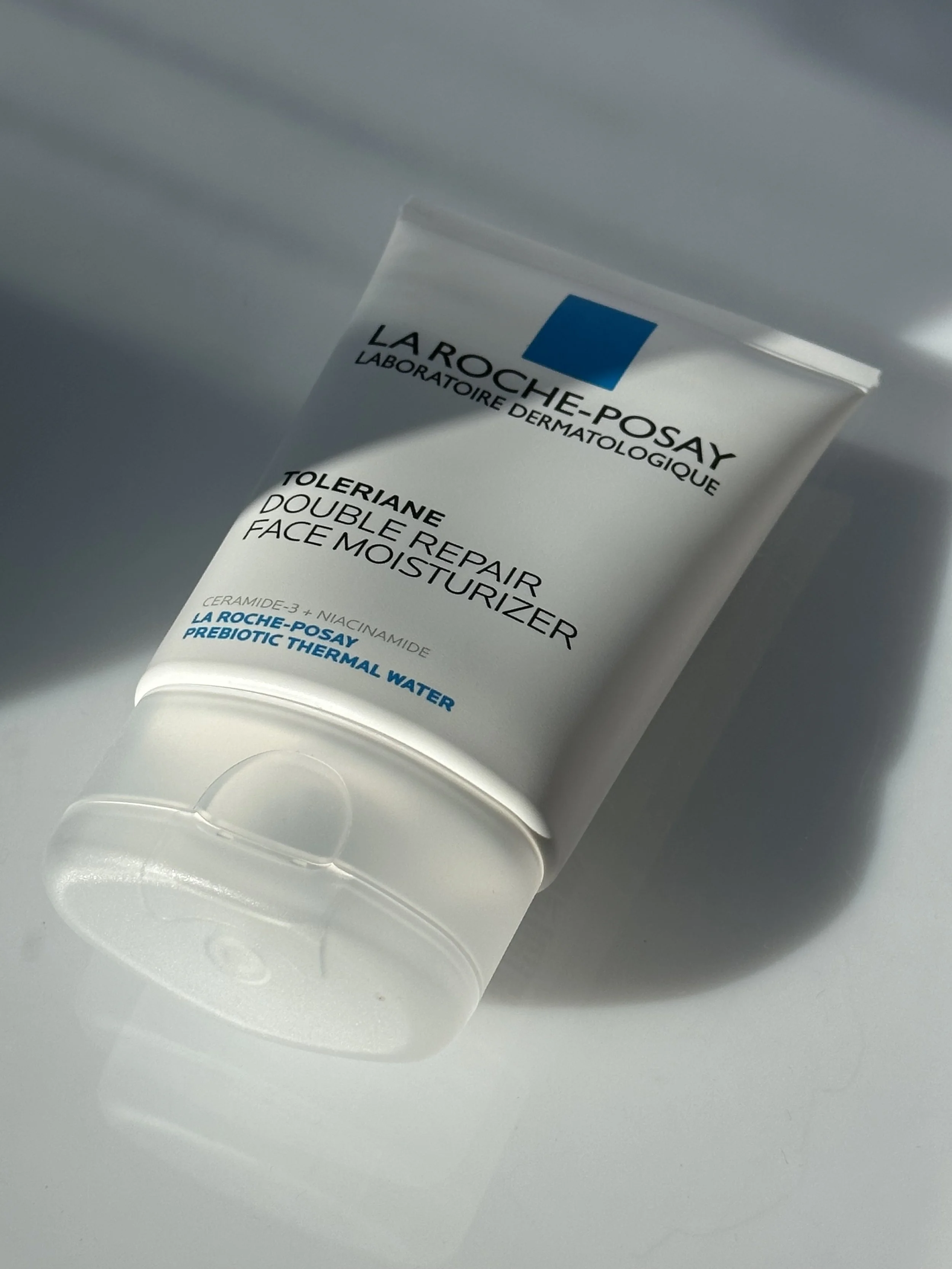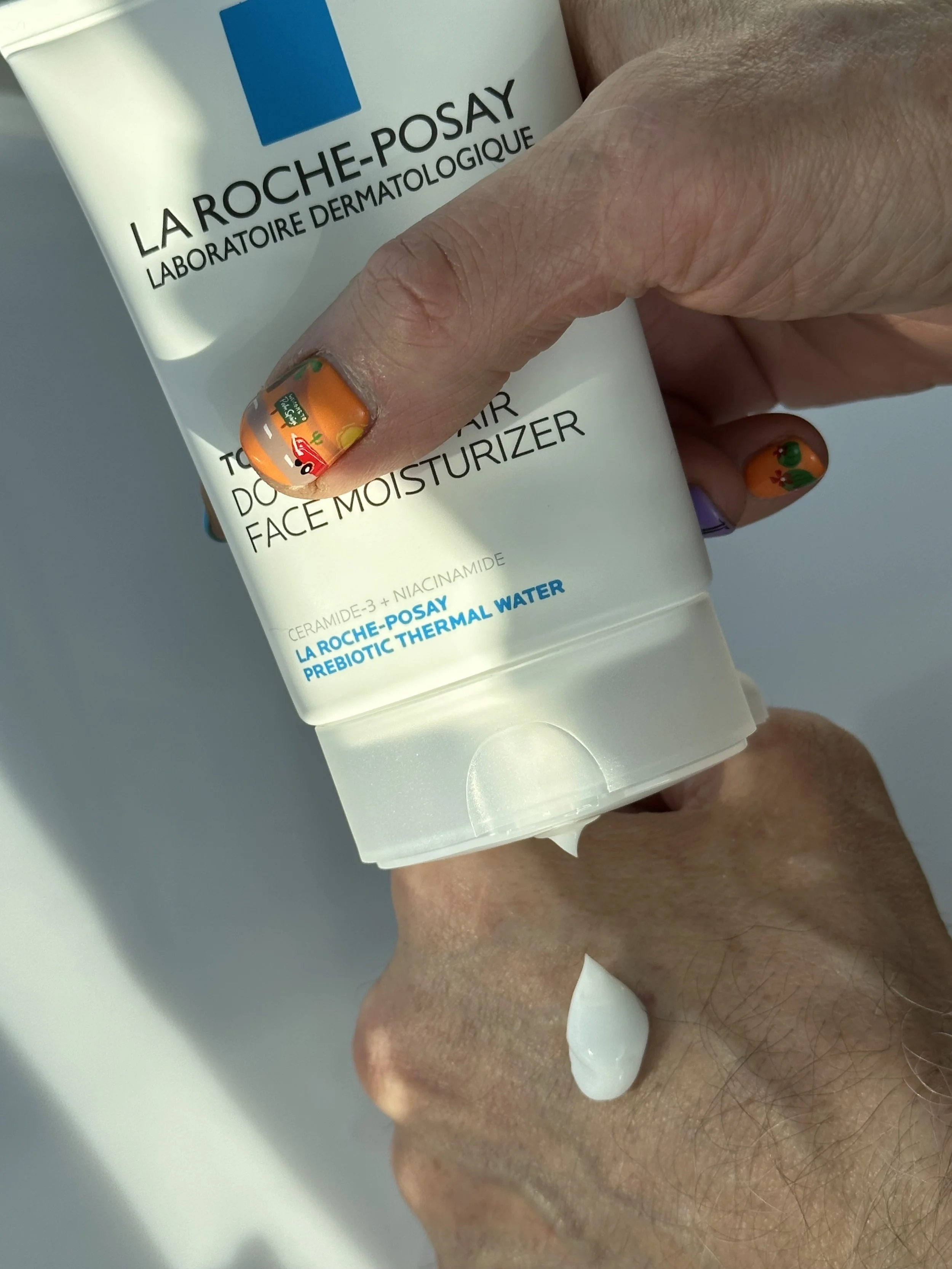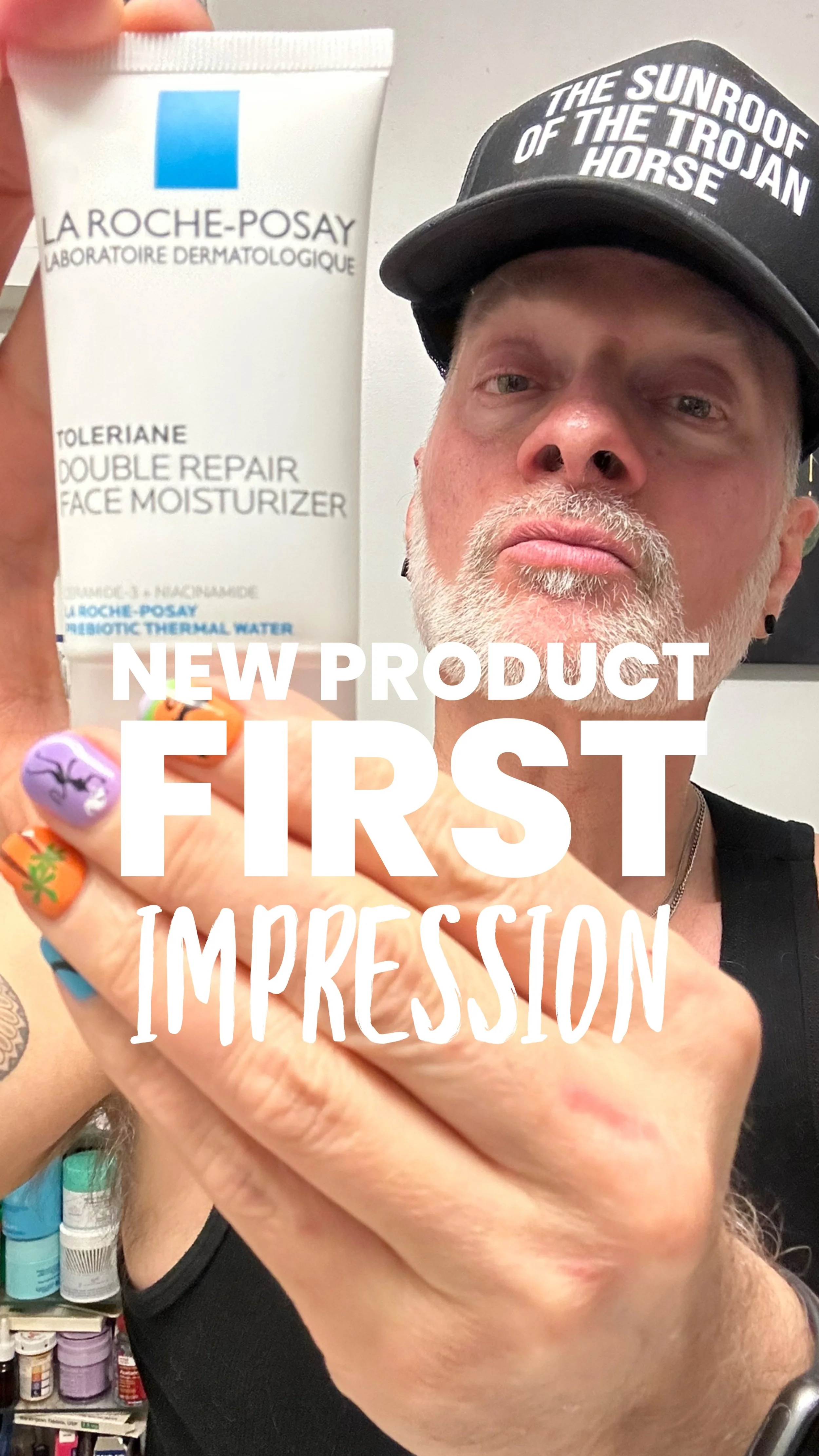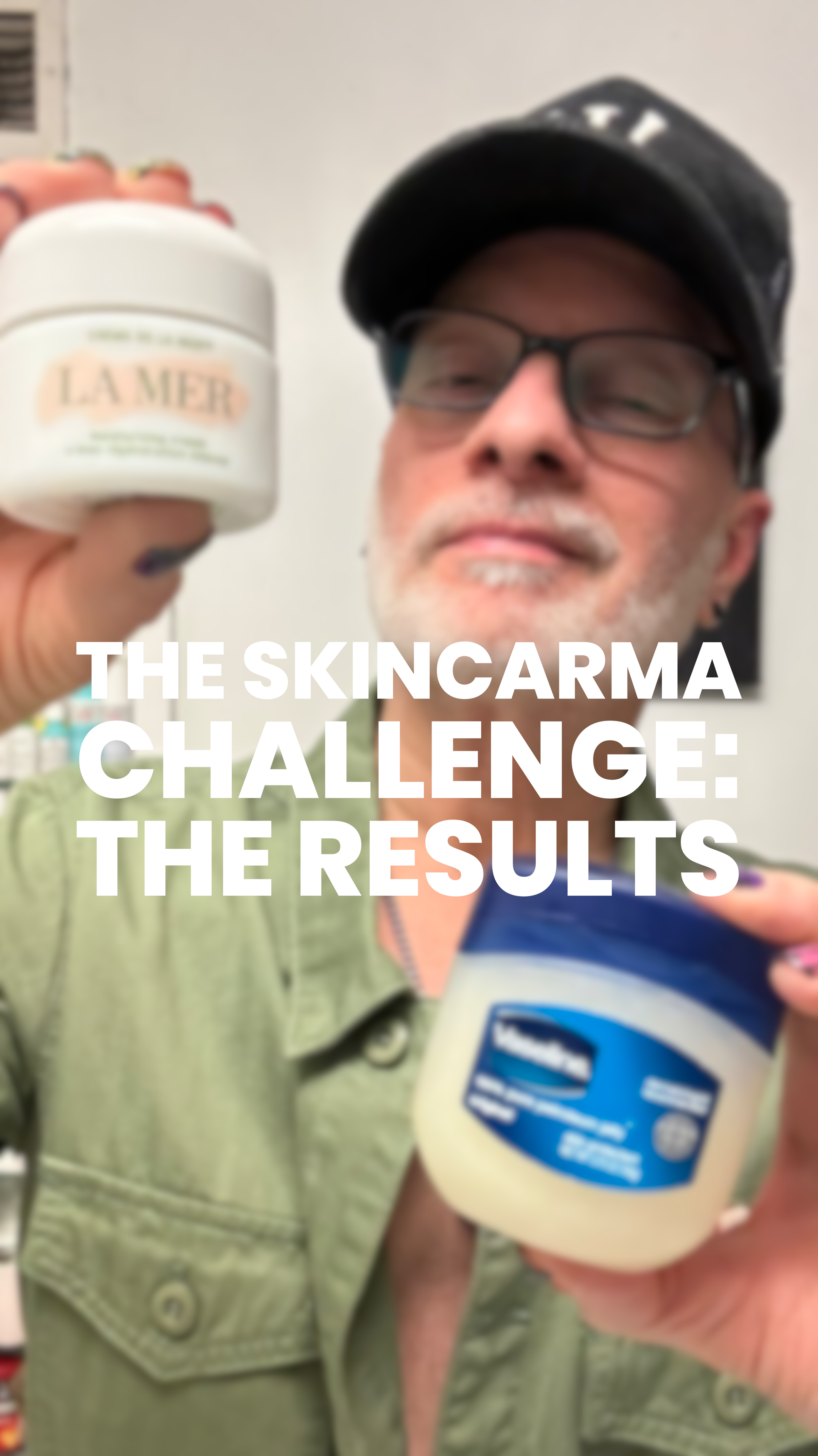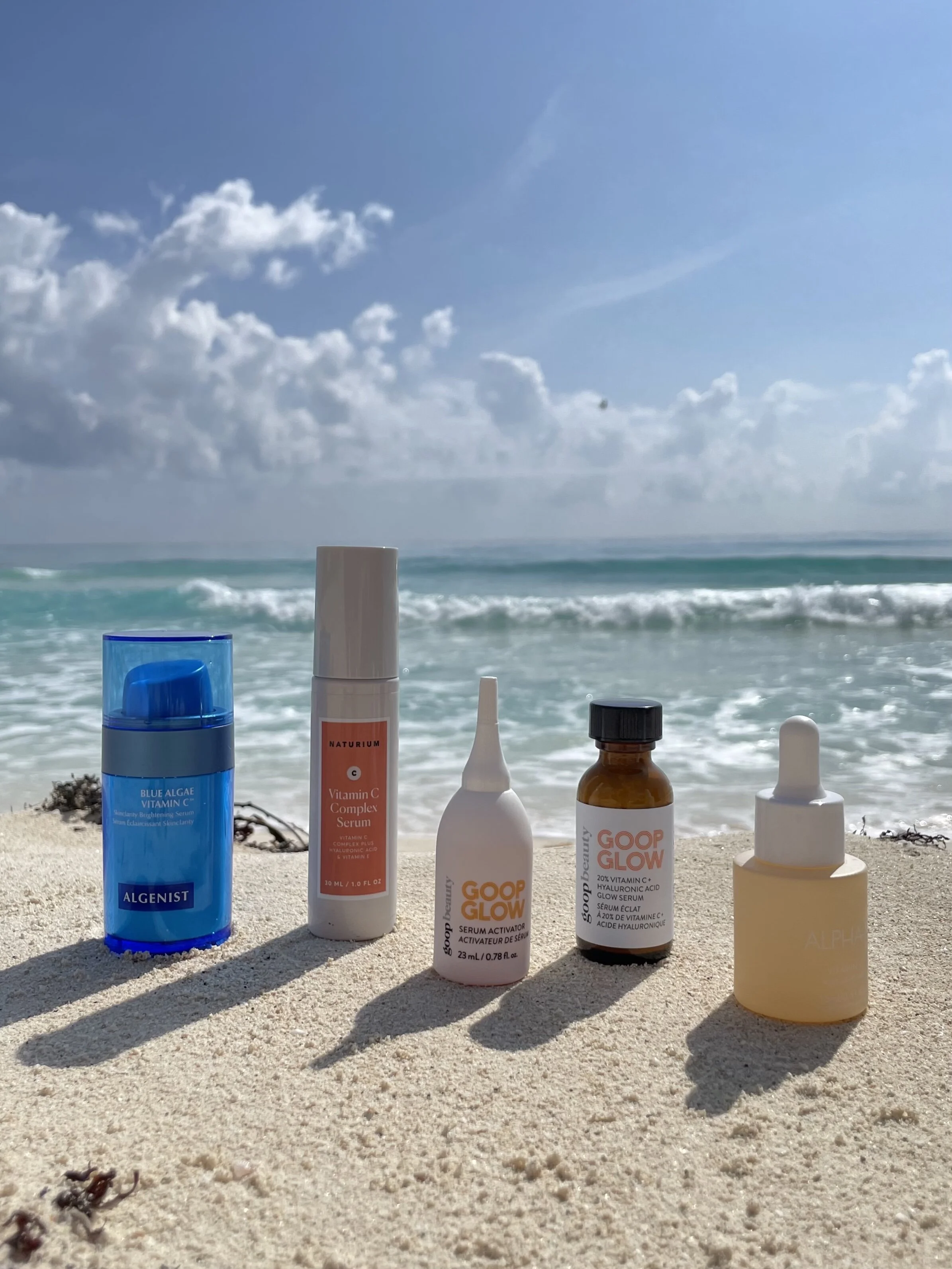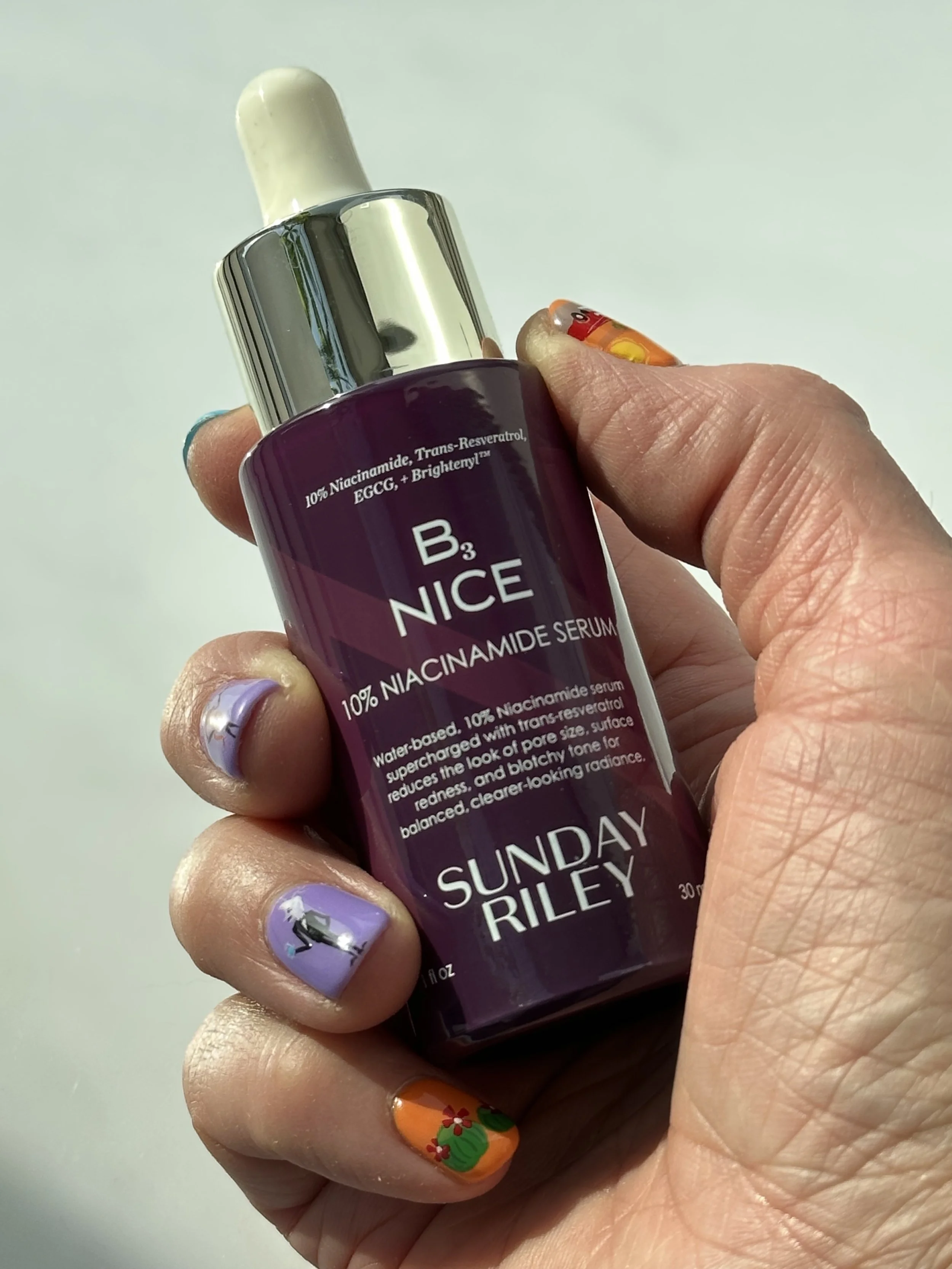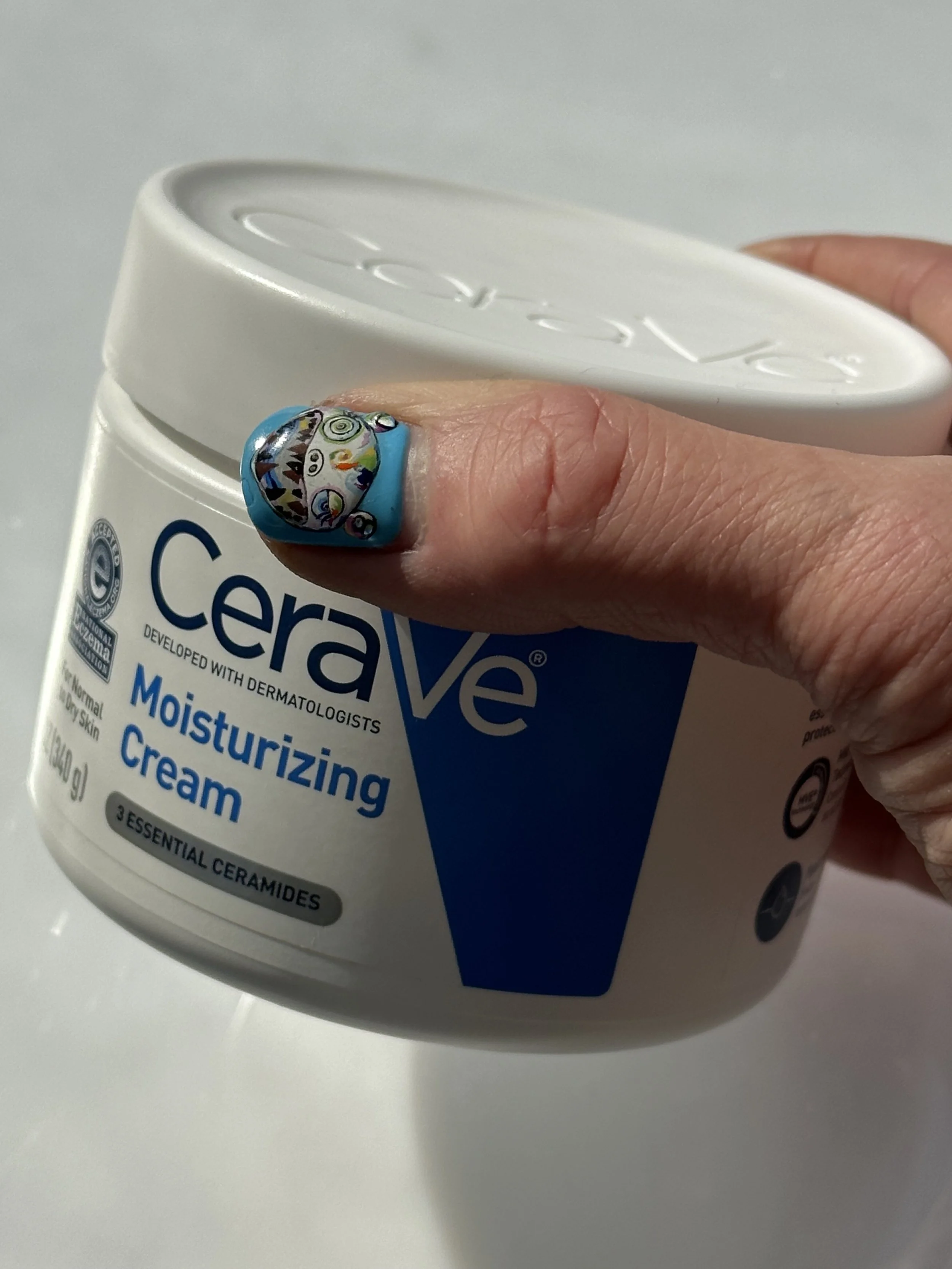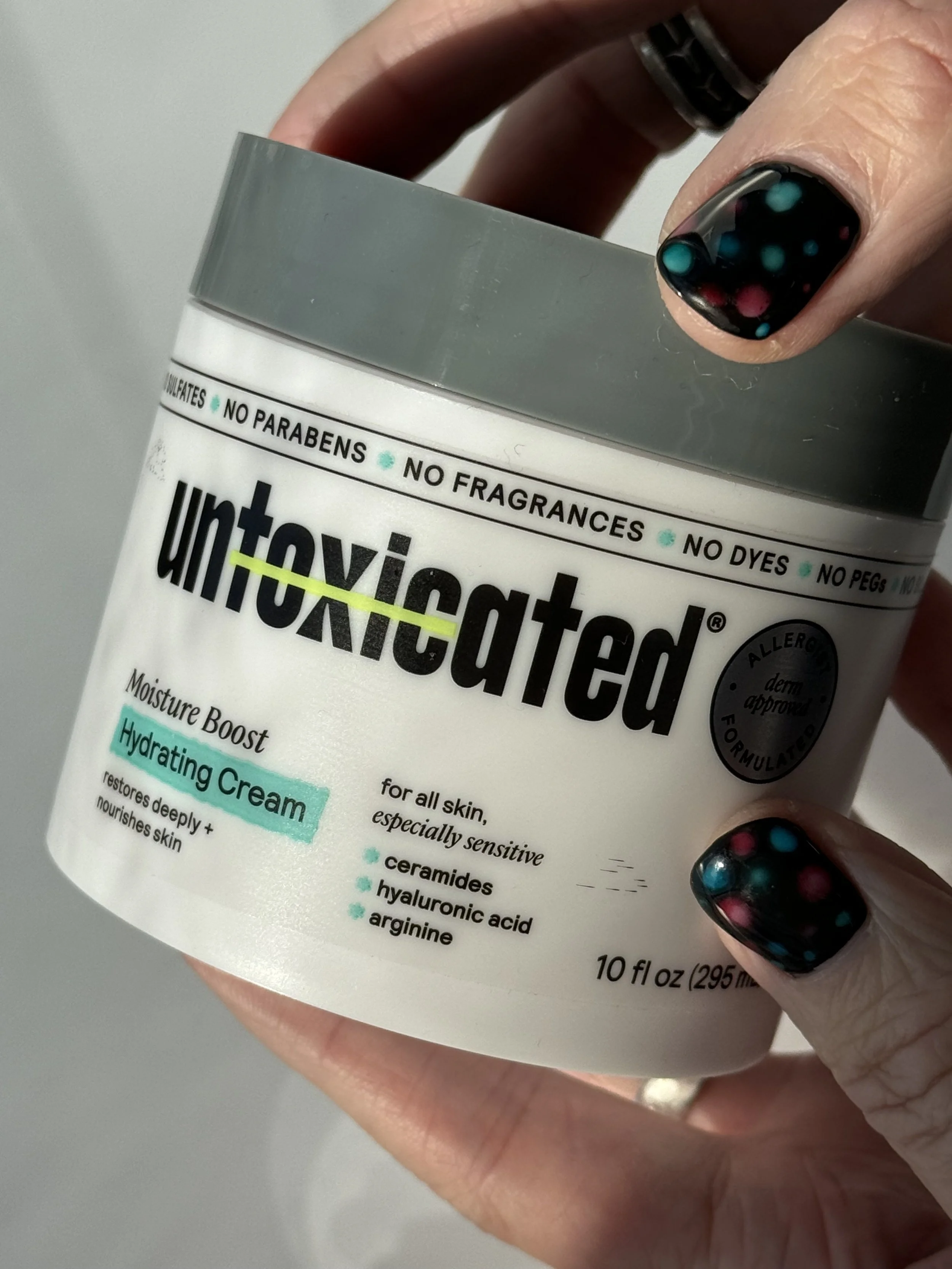PRODUCT REVIEW: LA ROCHE-POSAY TOLERIANE DOUBLE REPAIR FACE MOISTURIZER - What’s the Best Face Cream for Sensitive Skin? What Are Prebiotics in Moisturizer?
LA ROCHE-POSAY | TOLERIANE DOUBLE REPAIR FACE MOISTURIZER
I don’t rely on a face cream for anything more than skin barrier repair, protection and replenishment.
I know that sounds crazy to some people – and particularly those who believe the anti-aging claims of the big beauty companies.
There’s a reason why a $200 jar of Crème de la Mer from the Estee Lauder Companies is one of the best-selling skincare products of all time.
And why the iconic face cream is on multiple lists of the “best anti-aging creams”. This is despite the fact that it’s not supported by clinical testing proving anything close to efficacy as an anti-wrinkle cream, a firming cream, a treatment for hyperpigmentation – or as a solution for dull skin that even a basic brightening cream with Vitamin C could address.
Breaking news: Crème de la Mer is nothing more than a really expensive basic moisturizer.
What does a moisturizer do then? Well, a moisturizer should help replenish skin lipids like ceramides and fatty acids while preventing dryness and dehydration via trans-epidermal water loss (TEWL). These particular benefits of a face cream are essential during the dry, low-humidity months of winter when your skin struggles to remain moisturized and hydrated on its own.
The Best Face Creams for Dry Skin
Everything else – including antioxidant protection, skin brightening and age repair – is the work of more potent, targeted faces serums like the $20 Naturium Vitamin C Complex Serum or The Ordinary’s Granactive Retinoid 2% in Squalane. It’s just $12. Believe it or not, both of these affordable serums have more anti-aging benefits than a $200 jar of Crème de la Mer.
It’s all about the layering.
I use multiple targeted face serums in my skincare routines. Those include an antioxidant Niacinamide serum, a brightening Vitamin C serum and often a hydrating serum with Hyaluronic Acid or other humectants that help to prevent TEWL and subsequent skin dehydration.
Beyond replenishment, the purpose of a moisturizer is to seal it all in! Popular moisturizers like the Skinfix barrier+ Triple Lipid-Peptide Cream, the Paula’s Choice Omega+ Complex Moisturizer and, yes, even La Mer’s Crème de la Mer Moisturizer do an effective job of sealing in actives through an occlusive effect that functions like a veil over the skin to prevent water loss.
PRODUCT REVIEW: SKINFIX BARRIER+ TRIPLE LIPID-PEPTIDE FACE CREAM AND TRIPLE LIPID-BOOST 360° EYE CREAM
One of my most recent face cream discoveries is the popular La Roche-Posay Toleriane Double Repair Face Moisturizer. Having worked on Kiehl’s at L’Oreal for seven years in the 2000s, it’s funny to me that I’ve never tried anything from the brand before. That’s even while I had access to it at cost with my employee ID at the company store!
We always considered La Roche-Posay to be one of the best skincare brands out of the dozen or so that the beauty conglomerate owned at the time. Even though its marketing and packaging give the impression that it’s endorsed and developed by dermatologists, it just didn’t appeal much to me.
Soon after I departed, L’Oreal added the CeraVe brand to its portfolio. So this year, I’ve set out to explore both the CeraVe and La Roche-Posay brands, including their ranges of antioxidant serums for face. Two weeks ago, I posted my CeraVe Skin Renewing Vitamin C Serum product review. You can catch it on the blog here.
I’ll admit up front that I’m not as impressed with the La Roche-Posay Vitamin C Face Serum and the brand’s new 10% Niacinamide Serum as I expected I would be. Both contain ridiculously high amounts of drying alcohol (Alcohol Denat. on an INCI). Which begs the question: Did a dermatologist who isn’t on payroll actually endorse these face serums?
For a die-hard La Roche-Posay user, it’s a good thing that the Toleriane Double Repair Face Moisturizer is a really effective moisturizer for dry skin because all that alcohol is drying you out!
PRODUCT REVIEW: CERAVE SKIN RENEWING VITAMIN C SERUM
Before I get deep into my La Roche-Posay’s Toleriane Double Repair Face Moisturizer review, I wanted to explore the functions of skin lipids, and the benefits of fatty acids and ceramides in a face cream, a bit more. As I said, replenishing depleted lipids in the skin is a feature of a really good moisturizer and the Toleriane Double Repair Face Moisturizer does contain ceramides for that purpose.
Essential to an effective, pro-skin health regimen is to replenish skin lipids, or fats, like ceramides and fatty acids. By replenishing these natural fats each day, a face cream like the Toleriane Double Repair Face Moisturizer or the Skinfix barrier+ Triple Lipid-Peptide Cream can help to keep your skin barrier healthy and functioning optimally.
What is the role of lipids for skin? That is, specifically, the lipids found in the upper layer, or epidermis – also referred to as the skin barrier.
According to the National Library of Medicine at the NIH:
The epidermal lipids of keratinocyte origin play an essential role in the skin’s barrier function. These lipids provide a barrier against the movement of water and electrolytes as well as a barrier against microorganism invasion.41 Especially the permeability barrier, which limits water and minerals, is localized to the outer layers of the epidermis, the stratum corneum (SC).
So, what are skin lipids and how do lipids function in the skin?
Well, human skin contains three essential types of lipids, or fats. They include ceramides, fatty acids and cholesterol – all terms that are likely familiar to you. Generally, the lipid content of our skin is composed of 16-20% ceramides, 25-30% cholesterol, and 50-60% free fatty acids.
Skin lipids are fats and oils found in the epidermis, the top layer of the skin.
Lipids play an important role in keeping the skin healthy by providing a barrier that prevents water loss, protecting the skin from infection, and reducing inflammation.
Lipids help skin to retain its shape and elasticity, which can help reduce the appearance of wrinkles.
Ceramides are responsible for holding the skin cells together, while cholesterol helps to keep the skin hydrated.
Fatty acids act as an anti-inflammatory and help to protect the skin from environmental assaults.
As I’ve been doing all year, I posed a few key questions to the AI at you.com. Here’s how the artificial intelligence answered the questions I asked about skin lipids, including ceramides.
What are ceramides and what do ceramides do for skin?
Ceramides are complex lipids that play a central role in cell membrane integrity [1], providing structural integrity to the skin barrier and regulating the barrier's permeability[1]. They are essential for the formation of the lipid matrix that makes up the skin barrier and helps maintain skin hydration. Ceramides also have an anti-inflammatory and antioxidant effect, providing additional protection against environmental stressors[2]. In addition to keeping your skin hydrated [2], ceramides can also help alleviate eczema and psoriasis by repairing breaks in the skin[3]. Adding ceramides to skin care products can help restore the skin's natural barrier [2], improve skin hydration, and reduce signs of aging[4].
Sources: [1] Ceramides: A class of lipids with links to heart disease - Mayo Clinic; [2] Ceramides for Skin: How They Can Help Moisturize and Repair Skin; [3] Kaczvinsky, J., & Menter, A. (2007). Ceramides and the skin: Natural moisturizing factor components critical for skin barrier function. Dermatologic Therapy, 20(6), 437-445.; [4] Mertin, D., König, I. R., & Gehring, W. (2014). Ceramides and Skin Function. Skin Pharmacology and Physiology, 27(3), 119-128.
What do lipids do in skincare?
Lipids are an important component in skincare and play a major role in maintaining healthy skin. Lipids help to form a protective barrier that prevents moisture loss and helps keep out bacteria, dirt, and other harmful substances. They also help to replenish the skin's natural oils and keep the skin hydrated. Additionally, lipids are essential for proper skin functioning, as they help to regulate the skin's pH balance and help to repair damaged skin cells.
Sources:[1] Draelos, Z. D. (2008). Cosmetic Dermatology: Products and Procedures. Hoboken, NJ: John Wiley & Sons. [2] Robinson, J. K. (2008). Dermatology for Skin of Color. New York: McGraw Hill. [3] Taylor, S. R., & Cook-Bolden, F. E. (2002). Skin Conditions in Ethnic Skin: Principles and Practice. New York: McGraw Hill. [4] Rawlings, A. V., & Lombardi, K. M. (2013). Cosmetic Dermatology: Principles and Practice. New York: McGraw Hill.
Which is better hyaluronic acid or ceramide?
While both hyaluronic acid and ceramides can be beneficial for the skin, there is no clear consensus on which is better. Studies have shown that hyaluronic acid can hydrate the skin, reduce wrinkles and promote wound healing. Ceramides, on the other hand, are lipids that help form the skin's protective barrier and lock in moisture.
One study published in the Dermatology Journal showed that a combination of hyaluronic acid and ceramides was more effective than either ingredient alone in improving skin hydration, barrier function, and wrinkle depth. Another study published in the International Journal of Cosmetic Science found that a combination of hyaluronic acid and ceramides was more effective than a ceramide-only cream in improving the skin's barrier function and hydration.
Overall, both hyaluronic acid and ceramides can be beneficial for the skin, and a combination of the two may be more effective than either ingredient alone.
Sources: References: [1] J.H. Kim et al., “Effects of a combination of ceramide, hyaluronic acid, and cholesterol on atopic dermatitis-like skin lesions in NC/Nga mice,” Dermatology, vol. 212, no. 3, pp. 253–263, 2006; [2] S. Rho et al., “The effects of a combination of ceramide, hyaluronic acid, and cholesterol on skin hydration, transepidermal water loss, and skin surface pH,” International Journal of Cosmetic Science, vol. 27, no. 1, pp. 17–23, 2005.
La Roche-Posay Toleriane Double Repair Face Moisturizer
As I said, it’s taken me quite a few years to come around to exploring the La Roche-Posay brand. There are multiple ranges; among them are Effaclar for oily and acne-prone skin, Lipikar for dry skin and eczema, and Anthelios, the brand’s iconic collection of sunscreens for face and body.
La Roche-Posay offers so many products that I didn’t know where to begin. So I started at the most popular – the La Roche-Posay Toleriane Double Repair Face Moisturizer. At $23, it appears to be the brand’s best-selling product and is certainly one of the top face creams on the market.
Of course, I had not had the experience of the brand’s sub-par face serums either, including the La Roche-Posay Vitamin C Face Serum and the new 10% Niacinamide Serum. Both are loaded with drying alcohol at about a 5% concentration – a real skin irritant. So while I’m just getting started with them, I can already tell that I’m not going to be the biggest fan of La Roche-Posay’s anti-aging face serums.
But I am a fan of the brand’s face cream for dry skin, normal skin and combination skin – the Toleriane Double Repair Face Moisturizer! It’s a combination of texture, simplicity and formulation for me.
As with all of La Roche-Posay’s formulas, the Toleriane Double Repair Face Moisturizer is infused with the brand’s famed thermal water – at ingredient number one. Only recently did the brand begin to market its nutrient dense spring water as rich in prebiotics, the substances that feed the healthy bacteria on our skin.
What are prebiotics? Well, prebiotics are a type of dietary fiber that feeds the friendly bacteria found in the microbiomes of your gut and the surface of your skin. These non-digestible carbohydrates are found in many foods, such as fruits, vegetables, nuts, seeds, grains, legumes – and apparently thermal spring water.
Prebiotics help to promote the growth and activity of beneficial bacteria in the gut, which can improve digestive health, boost the immune system, and reduce inflammation. On the skin, they help maintain balance to defend against skin sensitivity and acne breakouts. They’re essential for your skin barrier health.
And the La Roche-Posay Toleriane Double Repair Face Moisturizer is one of the better face creams I’ve come across for overall skin barrier repair and maintenance.
SKINCARMA ON TIKTOK
La Roche-Posay’s Toleriane Double Repair Face Moisturizer is a relatively simple formulation that does an effective job of maintaining skin’s hydration and moisture levels. I put that to the test with a tool I use to gauge the efficacy of any face cream.
At the start of the year, I used my magic moisture wand in a split-face comparison of a $200 jar of Crème de la Mer Moisturizer and $7 jar of Vaseline. How did they compare? You can catch the surprising results here.
Last week, I used the same moisture wand to assess the efficacy of the Toleriane Double Repair Face Moisturizer. You can catch the results on my TikTok page here. In summary, La Roche-Posay’s popular face cream did a great job of maintaining my skin’s moisture content; and notably, it not only kept my skin hydrated overnight, it actually improved my skin’s water content by the morning.
I have to admit, I was surprised at how well it functioned! At $23 (2.5 oz / 75 ml), it’s a relatively basic, inexpensive face cream. No anti-aging and antioxidant vitamins or botanical extracts, no replenishing plant oils, or even plumping peptides. I was expecting solid moisturizing results, but wasn’t expecting an improvement in hydration levels. That’s an indication of the efficacy of the formula’s blend of humectants that draw water to the skin – as well as its ability to prevent TEWL in the first place.
In addition to a healthy level of humectant Glycerin and the brand’s prebiotic thermal water, the La Roche-Posay Toleriane Double Repair Face Moisturizer contains about a 2-4% concentration of antioxidant Niacinamide. While I wouldn’t rely on this face cream to deliver the Niacinamide needed to maintain my overall skin health, you can’t get enough of the multi-benefit active in your routine. Pair it with a Niacinamide serum like The Ordinary’s $10 Niacinamide 10% + Zinc 1% and you’re set.
The Toleriane Double Repair Face Moisturizer is not a natural face cream. In fact, I don’t think there’s anything natural in it – apart from that thermal water. Instead, it’s loaded with all kinds of chemical esters, emollients and stabilizers. There isn’t a single straight up plant oil in the formula, rare for a replenishing moisturizer.
One of the qualities I appreciate most is its exceptional texture. It’s just about perfect for my normal, balanced skin – not too light, not too heavy. If your skin is oily, it may be fine for you. If you’re super dry, you’ll likely need something heavier – and certainly something that contains beneficial plant oils like Squalane, Jojoba Seed Oil, Rose Hip Seed Oil et al.
As for what La Roche-Posay means by “double repair,” you got me there. I have no clue.
What I like about it: The La Roche-Posay Toleriane Double Repair Face Moisturizer is a relatively good basic moisturizer to moisturize, hydrate and balance skin. Paired with a well-formulated Niacinamide serum and a Vitamin C serum, it can play an essential part in a well-rounded approach to skin health. And jeez, I really love the texture!
What I don’t like about it: Even though LRP claims its prebiotic thermal water possesses antioxidant properties, Niacinamide is the only actual antioxidant in the formula. At about 2-3%, IMO it’s not sufficient enough for daily environmental defense. I wish it had more antioxidants but, at $23, you get what you pay for.
Who it’s for: All skin types except very dry, very oily, or acne-prone.
SHOP THE BLOG: Purchase the La Roche-Posay Toleriane Double Repair Face Moisturizer for $22.99 here.
The Ingredient List of the La Roche-Posay Toleriane Double Repair Face Moisturizer:
 sii|h 0 0, Dimethicone emo 0 1, Hydrogenated Polyisobutene emo|vc 2 1, Niacinamide
sii|h 0 0, Dimethicone emo 0 1, Hydrogenated Polyisobutene emo|vc 2 1, Niacinamide  cci|sb|aacne|h, Ammonium Polyacryloyldimethyl Taurate vc, Myristyl Myristate emo 2 0-5, Stearic Acid emo|vc 0 2-3, Ceramide Np
cci|sb|aacne|h, Ammonium Polyacryloyldimethyl Taurate vc, Myristyl Myristate emo 2 0-5, Stearic Acid emo|vc 0 2-3, Ceramide Np  sii, Potassium Cetyl Phosphate emu|surf, Isobutane, Glyceryl Stearate Se emu 2 3, Sodium Hydroxide buff, Myristic Acid surf|emu|perf 0 3, Palmitic Acid sii|emo|emu 0 2, Capryloyl Glycine surf, Caprylyl Glycol h|emo, Xanthan Gum vc, T-Butyl Alcohol perf|solv, Acrylonitrile/Methyl Methacrylate/Vinylidene Chloride Copolymer, Tocopherol
sii, Potassium Cetyl Phosphate emu|surf, Isobutane, Glyceryl Stearate Se emu 2 3, Sodium Hydroxide buff, Myristic Acid surf|emu|perf 0 3, Palmitic Acid sii|emo|emu 0 2, Capryloyl Glycine surf, Caprylyl Glycol h|emo, Xanthan Gum vc, T-Butyl Alcohol perf|solv, Acrylonitrile/Methyl Methacrylate/Vinylidene Chloride Copolymer, Tocopherol  aox 0-3 0-3
aox 0-3 0-3MY TOP VITAMIN C PICKS FW21: NEW VITAMIN C SERUMS I’M CRUSHING ON FROM ALGENIST, NATURIUM AND MORE
WATCH MY VIDEO REVIEW
THE BEST NIACINAMIDE SERUMS FOR CLOGGED PORES AND A BRIGHTER COMPLEXION
ON MY YOUTUBE CHANNEL HERE
WATCH MY VIDEO REVIEW OF
SKINCARE HACKS: GLYCOLIC ACID IS THE NATURAL DEODORANT THAT WORKS!
ON MY YOUTUBE CHANNEL HERE
WATCH MY VIDEO REVIEW OF
MY FAVORITE HUMECTANT SERUMS FROM PAULA'S CHOICE, THE INKEY LIST, GHOST DEMOCRACY AND MORE
ON MY YOUTUBE CHANNEL HERE
WATCH MY VIDEO REVIEW
COOL CLEAN FACIAL SUNSCREENS TO KEEP US SAFE AND SMILING IN THE SUN!
ON MY YOUTUBE CHANNEL HERE
WATCH MY VIDEO REVIEW
THE OPULUS BEAUTY LABS RETINOL SYSTEM – THE COOLEST RETINOL INNOVATION I’VE EVER SEEN
ON MY YOUTUBE CHANNEL HERE
WATCH MY VIDEO REVIEW
MY 2021 VITAMIN C PICKS + THE BEST VITAMIN C SERUMS TO BRIGHTEN UP THE COMPLEXION!
ON MY YOUTUBE CHANNEL HERE
WATCH MY VIDEO REVIEW OF
MY WINTER SKIN SAVIOR: SKINFIX BARRIER+ LIPID REPLENISHING SKINCARE
ON MY YOUTUBE CHANNEL HERE
WATCH MY VIDEO REVIEW
A COMPLETE K-BEAUTY ROUTINE WITH THE BEST FACIAL SKINCARE FROM PURITO, COSRX, MISSHA & MORE!
ON MY YOUTUBE CHANNEL HERE
WATCH MY VIDEO REVIEW
THE YEAR’S BEST VITAMIN C SERUMS WITH PAULA'S CHOICE, SUNDAY RILEY, THE INKEY LIST AND MORE!
ON MY YOUTUBE CHANNEL HERE
WATCH MY VIDEO REVIEW OF
A SELFCARE SUNDAY NOT FOR THE FAINT OF HEART – WITH THE PAULA’S CHOICE 25% AHA PEEL!
ON MY YOUTUBE CHANNEL HERE


